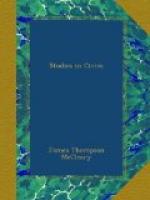The mode of selecting grand jurors is in general the same in all the states. The steps are three: first, the careful preparation of a list of persons in the county qualified to serve; second, the selection, by lot, from this list of the number of persons needed; third, the summoning of the persons so chosen. The number of persons in the first list is from two to three times the number of jurors. The preparation of the list is in some states entrusted to the county board; in others, to jury commissioners; in others, to the local boards. The names are reported to the clerk of the court, who in the presence of witnesses, makes the selection by lot. The summoning is done by the sheriff.
On the first day of the term, the court appoints one of the jurors foreman. The jury is then sworn, and, after being charged by the court, retires to a private room and proceeds to the performance of its duty.
The deliberations of the grand jury are conducted in secret. It may, however, summon and examine witnesses, [Footnote: Witnesses for the accused are not usually examined by the grand jury.] and may have the advice of the court or of the county attorney.
The fact that a crime has been committed within the county may be brought to the notice of the grand jury by any member thereof or by any other person. If upon examination there seems to be reason for believing that it was committed by the person accused, the county attorney is called upon to frame a formal accusation against him, called an indictment, which is endorsed with the words “a true bill,” and sent to the court. Upon the indictment the person accused is arrested and tried.
If the evidence against the accused is insufficient to warrant indictment, but yet his innocence is questionable, the grand jury may bring a presentment against him. This is an informal statement in writing addressed to the court setting forth the offense and stating that there is a reasonable probability that a certain person, named, has committed it. A person arrested on a presentment is examined before a justice of the peace or other magistrate, as if arrested on a complaint. Neither an indictment nor a presentment can issue except upon concurrence of the number of grand jurors specified by statute. Under former practice the jury numbered twenty-three and the concurrence of twelve was necessary.
The grand jury is bound to investigate the charge against any one held by a justice “to await the action of the grand jury;” also any charge brought by a member of the grand jury. And conversely it is the sworn duty of each member to report any crime known by him to have been committed within the county. Any outsider may file information or bring charges, but the grand jury may use its own judgment as to the necessity of investigating them.
Petit Jury.—A petit jury is a body of twelve men impaneled and sworn in a district court to try and determine by a true and unanimous verdict, any question or issue of fact, in any civil or criminal action or proceeding, according to law and the evidence as given them in court.




